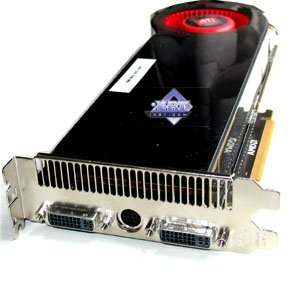Today we are going to preview a dual-GPU monster based on R700, the ATI RADEON HD 4870 X2 (R700) 2x1024MB. This article is exclusive enough, because the official announcement is scheduled only to August.
Instead of doubling the memory capacity of HD 4870 512MB, this novelty has four times as much: 2x1024MB (2GB) RAM. Note that it would be incorrect to simply sum up memory capacity of a dual-GPU card, because each core utilizes its own memory exclusively. Only marketeers do that to promote a product.
Keeping within the framework set by AMD, we will briefly describe architecture, the card itself, and will run a few game tests. Though architecture doesn't need much describing, just multiply all the primary specifications of 4870 by 2.
RADEON HD 4870 X2 specifications
- Codename: R700 (2 x RV770);
- Process technology: 55nm;
- 2 GPUs, 956M transistors each;
- Unified architecture with an array of shared processors for stream processing of vertices, pixels and other types of data;
- Hardware support for DirectX 10.1, including Shader Model 4.1, geometry generation and stream output;
- 2 x 256-bit memory bus, 4 x 64-bit controller supporting GDDR3 and GDDR5;
- 750 MHz core clock;
- 2 x 10 SIMD cores, including 2 x 800 scalar ALUs, integer and FP calculations, FP32/FP64 support, according to IEEE 754;
- 2 x 10 larger texture units supporting FP16/FP32;
- 2 x 40 texture addressing units;
- 2 x 160 texture fetch units;
- 2 x 40 bilinear filtering units supporting full-speed FP16 texture filtering and trilinear and anisotropic filtring support for all texture formats;
- Dynamic branching in pixel and vertex shaders;
- 2 x 16 ROPs supporting AA modes with programmable fetch of over 16 samples/pixel, including FP16/FP32 frame buffer. Up to 32 samples/clock (including MSAA 2x/4x modes and FP16 buffer), 128 samples/clock in Z only mode;
- Simultaneous write to up to 8 frame buffers (MRT);
- Support for 4 x RAMDAC, 4 x Dual Link DVI, HDMI, HDTV, DisplayPort (only 2 available);
So there. Those of you willing to know more about the RV770 architecture may consider reading this RADEON HD 4850 review.
Graphics card
| ATI RADEON HD 4870 X2 2x1024MB |
- GPU: 2 x RADEON HD 4870 (RV770);
- Interface: PCIe x16;
- GPU (ROPs/Shaders) clock rate: nominal 750/750 MHz;
- Memory clock rate, physical (effective): nominal 900 (3600) MHz;
- Bus width: 2 x 256-bit;
- Vertex processors: -;
- Pixel processors: -;
- Universal processors: 2 x 800;
- Texture processors: 2 x 40 (BLF/TLF);
- ROPs: 2 x 16;
- Size: 270 x 100 x 33 mm (the latter is max. width);
- PCB color: black;
- RAMDACs/TDMS: integrated into GPU;
- Outputs: 2 x DVI (Dual-Link/HDMI), TV-out (integrated into GPU);
- VIVO: -;
- Multi-GPU: Hardware CrossFire
|
 |
| ATI RADEON HD 4870 X2 2x1024MB |
2x1024 MB GDDR5 SDRAM in total of 16 Hynix chips on both sides. Chips are designed for max. clock rate of 1000 (4000) MHz.
|
 |
| Comparison with the reference design, front view |
| ATI RADEON HD 4870 X2 2x1024MB |
Reference ATI RADEON HD 3870 X2 2x512MB |
 |
 |
| Comparison with the reference design, back view |
| ATI RADEON HD 4870 X2 2x1024MB |
Reference ATI RADEON HD 3870 X2 2x512MB |
 |
 |
It is obvious that the design concept was borrowed from 3870 X2. Changes are related to DDR5 memory and higher requirements to power circuitry. As for the CrossFire mode, the board features a new PEX bridge from PLX Technologies.
Graphics cards of this family are equipped with built-in audio codec. So this audio stream is then transmitted to HDMI (via a DVI-to-HDMI adapter). So if this function is important to you, make sure the bundle includes this adapter.
Also note that the card has a 6-pin and an 8-pin power connectors situated similar to 3870 Õ2.
The card has TV-Out with an original connector. You will need a special bundled adapter to output video to a TV set via S-Video or RCA.
Analog monitors with D-Sub (VGA) interface are to be connected via special DVI-to-D-Sub adapters. Since there are also DVI-to-HDMI adapters bundled with such cards, so should be no monitor problems.
Maximum resolutions and frequencies:
- 240 Hz max. refresh rate
- 2048 x 1536 x 32bit @ 85Hz analog
- 2560 x 1600 @ 60Hz digital (Dual-Link DVI)
What concerns MPEG2 playback features (DVD-Video), we analyzed this issue in 2002. Little has changed since that time. CPU load during video playback on modern graphics cards does not exceed 25%.
What concerns HDTV, a review is available here.
Cooling
The cooler is the same as that of 3870 X2, only heatsinks are more efficient.
The operation principle is the same: a turbine drives air through the heat sink. There is a big advantage: hot air is blown out of enclosure and does not stay inside. However, on 3870 X2 cooler remains silent while providing sufficient cooling. But the novelty might be rather noisy due to airflow. Memory chips are cooled by a special heatsink plate.
Unfortunately, RivaTuner does not support the novelty yet, so we don't have monitoring results. But the card is very hot. Seems like the core is 80 or more degrees Celsius hot.
Write a comment below. No registration needed!
